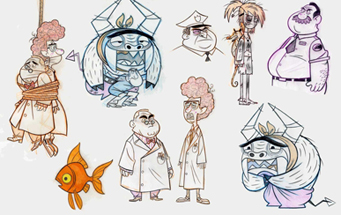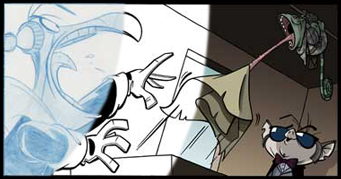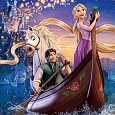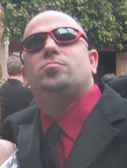 The character designer of The Fairly Odd Parents, Danny Phantom, Foster’s Home for Imaginary Friends and various direct to video Disney projects, Ben Balistreri, is now also ready to add comic book artist to his resume.
The character designer of The Fairly Odd Parents, Danny Phantom, Foster’s Home for Imaginary Friends and various direct to video Disney projects, Ben Balistreri, is now also ready to add comic book artist to his resume.
Animated News & Views’ Jeroen Van Zwol speaks exclusively to Ben about his career and the upcoming publication of his own self-penned project, Seaweed, with many of the following images able to be viewed in a larger size when clicked.
Animated Views: When did you decide that you wanted to work in the animation business?
Ben Balistreri: I was starting to look into the idea of a career in animation as a senior in High School. I read The Illusion of Life and was fascinated. I was on the fence about whether to really go down that path cause I knew it would take a lot of work but when Beauty and the Beast came out in 1991 during my first year in college I knew I had to go down that path.
AV: Could you describe the journey that lead to your finally becoming an animator?
BB: I was enrolled as an illustration major at the University of Arizona. From everything I had read, Cal Arts was the place to be if you wanted to learn Disney style character animation. I worked pretty hard to get accepted into Cal Arts. I got rejected my first time and then devoted a year to drawing at the zoo every day and taking lots of life drawing classes. I got accepted on my second try. I think being rejected my first time taught me a lot about perseverance and hard work. I went into my time at Cal Arts with a real hunger to prove myself, and it paid off. I got hired out of school at the end of my second year by Disney TV, where I went on to design on the Little Mermaid Video sequel.
AV: While at CalArts, why did you create model sheets for Aida and Don Quixote?
BB: Aida was a design assignment in one of my character design classes. The Don Quixote designs were done at a summer program called The Disney Boot Camp. That was a month long program that Disney tried out were they gathered art students from around the country and taught them about animation. The program only lasted the one time so I was lucky enough to take place in it. To be clear, the Don Quixote work wasn’t development for the proposed feature. It was simply some development I did on my own at the camp.
AV: Are you amazed that many people believe the designs originated at Disney?
BB: Yah! I saw them posted on a website as development for projects that Disney never did. I’m pretty surprised any one thought they were good enough to even be mistaken for real development work!

(Click to view high-res version)
AV: Would you please elaborate on the Viking Family project you worked on for Disney?
BB: Those were actually just secondary characters for a short that got cancelled called Living in Limbo. I did a ton of designs for the short but it got cancelled after the board pitch. The reason I heard was that once the head of Disney TV saw the story pitch he didn’t think it would make a full series if it went past the short phase.
AV: Which do you enjoy drawing for more: comics or animation?
BB: I don’t really see a difference between the two. Drawing my comic is my greatest passion, but that’s only because it’s entirely my own project and characters. That doesn’t change the fact that I love working on great projects like Foster’s or Danny Phantom. In the end it’s all about trying to do something great no matter what the medium.
AV: What are some of the comparisons and contrasts between the animation studios for which you’ve worked?
BB: Honestly, there’s not a whole lot of differences between the studios themselves. There are always cool perks. Cartoon Network gives us lots of free toys and promotional items, Nickelodeon had a lot of fun events at the studio, Disney gave us yearly free passes to Disneyland. As far as working conditions they all are pretty relaxed and if you get your work done well and on time, they don’t bother you. It really comes down more to the specific Director and Producer your working for then the studio itself.
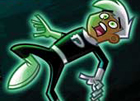 AV: How did you become involved with Danny Phantom?
AV: How did you become involved with Danny Phantom?
BB: One of my good friends, Shannon Tindle, had been doing early development on Danny Phantom. He left to go work on The Proud Family and he recommended me for the job. I also had worked for the producer, Deirdre Brenner before, so she put in a good word for me. It’s important when you’re working to keep good contacts cause you will definitely need them in the future.
AV: What is the story behind the Crash Nebula spin-off series that was once planned?
BB: Crash was a character that “Timmy Turner” watched on The Fairly Odd-Parents. Butch Hartman, (the creator of Fairly Odd Parents, Crash Nebula and Danny Phantom) and Steve Marmel (the Story Editor on all those shows) had written the pilot episode for Crash while Danny was still being developed. Steve Silver and I got to create the look for the show as well as tie down the storyboards that Eric Weise created. Everyone was really high on the look for the show, but it didn’t test very well in the focus group that saw it. Also Butch was pretty busy with Fairly Odd Parents and Danny getting ready to start so I think the network thought that three shows would be too much. The pilot still airs on Nickelodeon as a Fairly Odd Parents episode, so at least it made it on TV.
 AV: Is it true that a Crash Nebula movie was also considered?
AV: Is it true that a Crash Nebula movie was also considered?
BB: Yah, Butch and Steve had some plans but I’m not sure how far it went.
AV: What was working on Jack & Ben for Laika like?
BB: There were some fun things about being at a start up company but it wasn’t quite what I thought it would be. There were some talented people who I learned a lot from but I really never had much freedom to explore much on the movie so I ended up quitting after a few months. Also I never really liked living in Portland and wanted to get back to Los Angeles. One of those, “you don’t know what you’ve got till it’s gone” moments. I’ve since moved back to L.A. and I’m much happier.
AV: What can you tell us about Jack & Ben?
BB: Not much, I’;m sorry. It’s slated to be Laika’s first CG feature, and will be released after Henry Selicks stop motion film, Coraline. I can’t share anything about the story or designs yet but if you go to Laika’s website they have a blurb about it.
AV: Is Jack & Ben still scheduled to be released this year?
BB: No. I’m not sure if it ever was going to be. From what I hear they’re still working on the script , so it’ll probably still be a while before it comes out. I’ll be surprised if anything I did makes it into the movie as I think they’re going to go with a different artistic direction then the one I was being lead in.
 AV: How did you become the design supervisor for Foster’s Home for Imaginary Friends?
AV: How did you become the design supervisor for Foster’s Home for Imaginary Friends?
BB: Once again, my friend Shannon Tindle, left the job. I knew Craig McCrackin liked my work and had offered if I ever got time I could do some freelance on the show. I had just quit Laika, and knew from Shannon that they were looking for a new designer, so I called up the producer on Foster’s and after doing a quick design test to see if I could draw in the style they gave me the job.
AV: What can you tell us regarding future episodes of Foster’;s?
BB: The episodes I worked on for season five have just started to air. There is one episode were the characters go to a swap meet that is awesome. I can’t really go into specifics on shows that haven’t aired, of course, but some of the other episodes coming up are going to be amazing!
AV: When designing new characters, do you find it difficult maintaining the style of the project?
BB: Sure. Artists have their own way of drawing so it always takes a while to meld in with a new style. I’ve been lucky enough to work on projects as different as Cinderella 2 to Danny Phantom, so it’s getting a little easier. There are some basic drawing and design principles that are usually consistent in just about any style so knowing those helps. (No tangents, variation on shape sizes, eliminating parallel lines, and so forth.)
(Click to view high-res version)
AV: What is the most difficult thing you’ve ever been asked to draw or design?
BB: I had to draw Flounder from The Little Mermaid as an adult. Trying to keep the appeal of such a cute well thought out design was just stupid! What the hell happens to him as he gets older? Does he look like a real fish? Does he just get longer? One of those executive ideas that just never should have been attempted.
AV: Why did you decide to start a blog?
BB: It’s a great way to show my work! It’s fun to be able to draw something, post it, and know that people all over the world can see it instantly! It’s been a good way to get work and an easy way to have an on going portfolio. Plus my Mom likes to see my art.
AV: Have you ever accidentally posted some artwork or news that you had to remove?
BB: No.
AV: Posting some of your work-in-progress online, such as from your upcoming graphic novel, Seaweed, are you ever afraid someone might try to steal your designs?
BB: No. They along with everything I do is all under copy write protection. I’ve taken all the necessary steps to protect those ideas, and if anything, posting them gives a proof and documentation that the ideas are mine. Of course the only way to be completely safe would be to never show anything, but where’s the fun in that.
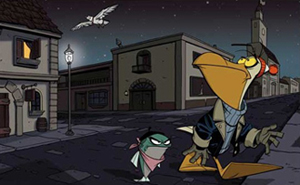 AV: Speaking of Seaweed, how did this project begin?
AV: Speaking of Seaweed, how did this project begin?
BB: I absolutely love Belgian and French comics. (TinTin, Asterix, Spirou and Fantasio, Gaston, Marsupilami…) I could go on forever. One thing about working in the animation industry is that you don’t get a lot of freedom to just do what you want. I started Seaweed as a way to just do everything my way with out any notes or opinions from anyone else and to satisfy my craving to tell a story in that French BD style.
AV: On your blog, you noted that most of your friends would rather see the rough blue version of the comic than a full-color version. Thus, why do you still want for Seaweed to be published in color?
BB: My goal with the book is to have people enjoy the story as a whole, not just the art. I really feel the full color treatment is necessary to have the mood and emotion come through the way I want it to. It’s also a great learning exercise. When you have to color as many panels as I have to you can’t help but improve. If the book does well enough I’ll publish an “art of” book with all the pencil versions and rough sketches, but the real goal is to tell a story and improve on skills I don’t use very much.
AV: Also on your blog, you wrote that your wife, Becca, created a Mildew the Bat plush for you. Is there a chance more of those plush toys, and perhaps similar Seaweed merchandise, will be created to sell publicly?
BB: I would certainly love to. My wife is a pretty amazing seamstress but she’s got her own projects going on so I don’t think she’ll have too much time for me! As far as other merchandise it’ll probably depend on how well the book sells. I’ll be investing a lot of money to publish the initial run so I don’t think I’m going to be able to produce toys just yet, but if there’s enough interest I certainly want to. I’ve got a couple t-shirt ideas I might put out when the book gets done.
AV: What is the current status of Seaweed?
BB: All 64 pages are written and drawn. As of now I have 30 pages fully inked and colored.
AV: Do you have an idea when Seaweed will be released?
BB: I’ve given up trying to guess. I’m hoping by the beginning of 2008 but it’s hard to promise. You can imagine how much work goes into something like this and I’m really trying not to hack through any of it. Of course it’s only a side project and I still have to devote most of my time to my full time job at Cartoon Network.
(Click image for a full page comparison)
AV: Who are some artists that you admire?
BB: Andre Franquin is my all time favorite. Albert Uderzo, Herge, Didier Conrad, Morris, Janry, Leturgie, Will, Peyo, Jean Barbaud, Pierre Alary, Dennis Bodart, are some of my favourite BD artists. Milt Kahl, Marc Davis, John Lounsberry, Ward Kimble, Chuck Jones, Tom Orb, are some of my favorite old time animators. Some current favs are Nicolas Marlet, Carlos Grangle, Craig Kellmen, Craig McCracken, (I’m not just saying that cause he’s my boss, that dude can DRAW!!) Glen Keane, Andres Deja, James Baxter, Mark Andrews, Tony Fucile, to name a few. I really admire Brad Bird’s storytelling ability as well.
AV: What advice would you like to offer anyone wanting to work in the animation industry?
BB: I know it can be tough to brake in, but if you’re really passionate about the art form it will just be a matter of time before you get your big break. The industry needs more artists who think for themselves and try to do something their own way as opposed to just copying the work of previous greats. Learn the fundamentals of figure drawing, perspective, and the basic laws of good design. It’s great if you want to break them but you can always tell the artists who are only doing an “artsy-fartsy” style cause they don’t have any skill as opposed to the ones who are consciously breaking new ground.
Try to come up with your own witty and brilliant observations from and about life. Practice drawing hands a little every day. Draw in a sketchbook but don’t show it to anyone. If you treat a sketchbook like an art piece it will stifle your ability to observe and practice. Don’t be satisfied drawing the same thing over and over, (there are lots of people who can draw profiles of people’s heads) learn to draw everything from rocks to smoke to tigers. Observe LIFE! I said that already but I thought it would be good to say again!
Our thanks to Ben Balistreri. For more information, be sure to visit his personal blog, where a large amount of artwork and inside stories from past and present projects can be viewed.


